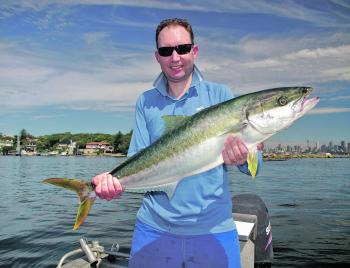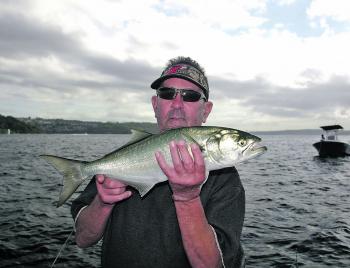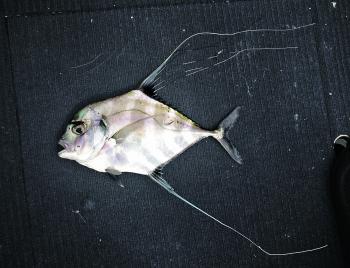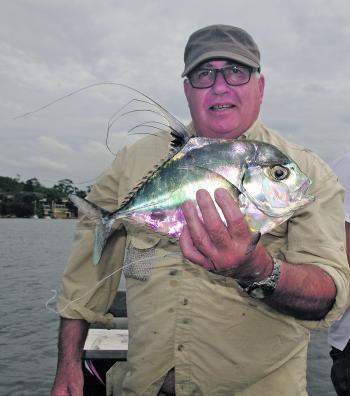The outstanding feature of this autumn has been a combination of very warm water, high rainfall and big seas. Sydney-siders are quite used to an Easter wash-out, but this season the rain started in early March and hasn’t really stopped. The fish don’t seem to know what’s going on, with winter fish like hairtail and dory being caught alongside tropical fish like cobia and rainbow runner.
The mullet run, which usually kicks off with the first westerly in April, started in late February. Kings have been patchy and it has been one of the worst seasons for surface fish that I can remember. A fish’s metabolism is directly related to water temperatures – the warmer the water, the faster they process a meal and the faster they grow. They eat more when the water is warm, which is good news for fishers up to a point – fish, like humans, can suffer from heat stress.
I lost a number of my prized aquarium fish to heat stress this summer. You know it’s hot when tropical fish are keeling over in Sydney. Particularly in the estuaries and bays, the water is usually at its warmest on the surface. With lower harbour surface temperatures topping 25°C and upstream at 28°C, no wonder the surface fish didn’t play this year.
There have been some upsides, however. The mulloway and snapper fishing has been the best anyone has seen for years. These fish stay deep and are therefore less affected by hot water. We have also seen the best mix of tropical fish in a long time. Pennant fish, long-nose trevally, rainbow runner, longtail tuna, amberjack, samsonfish, Watsons leaping bonito, barred longtom, grinners and cobia have all been caught in Sydney Harbour this season. I sat next to a boat at North Head that pulled in a 20kg cobia. With 24°C water still down past Eden, my prediction is that we will experience good fishing well into the winter months.
All the rain and big seas have led to some murky water at times, so here is a quick refresher on how to deal with it. What a good flush does, apart from turning the system upside down for a while, is inject it with a burst of nutrients. This comes from two main sources, the main one being in the form of plant, animal and mineral matter washed in off the land.
Secondly, depending on the extent of the flood, the river bed, along with the vast variety of marine organisms, gets lifted and dispersed downstream. Being an opportunistic feeder, bream are particularly turned on by a big flush. I’m expecting a solid turn-up this month.
The Spit Bridge, Balmoral, North Harbour, Sow and Pigs, Bottle and Glass and Bradleys Head should all produce well. The shallower spots like Balmoral and Sow and Pigs are best fished in the early morning, late afternoon and into the night. Once the sun is high in the sky, try the deeper areas like Bottle and Glass and North Harbour.
With a bit of colour in the water, baits like skirt steak, fresh tuna cubes, chicken and mullet gut and chicken breast fillet dipped in tuna oil seem to work better than live baits like yabbies, prawns and worms. There’s no doubting that once the water is back to its normal clear condition, the live baits will be way ahead.
A light berley is a definite advantage in attracting bream. I once fished next to a boat that I considered to be berleying excessively. The anglers’ mix consisted of a typical grain-based berley with what should have been a dash, but was in fact probably half a bottle of tuna oil (we all do it) and it was going in by the bucket full. Consequently many the bream we caught were bloated with oats. My bet was that there were fish still down there that were so full that they had stopped feeding.
Berley is designed to attract fish, not feed them. Your bait is there to feed them. Keep the berley regular, but just a sniff.
My berley system consists of a few fresh fish frames in the PVC berley pot and a gentle stir every ten minutes or whenever I remember – usually the later. It’s comical to watch some of my crew, who previously had no interest in berley, become human berley pot pistons when the fish turn up.
Flathead also come on strong after the rain, attracted by the abundance of baitfish that have been flushed down. All the areas mentioned above are fishing well for flatties. If you plan to anchor for flatties, find a drop-off on a sand bottom or an area of broken sand reef. Live baits are the way to go when at anchor as the flatties like a moving bait.
Drifting the shallow sand areas around Balmoral and Rose Bay is extremely productive, although the fish, while in numbers, tend to be smaller. White bait or anchovies make good drift baits, but once again, livies pinned through the top lip are way ahead.
Middle Harbour is relatively deep and only has a small catchment, so it should still hold a few fish, regardless of its resemblance to the Murray. I’ve even caught kings in muddy water up here. My bet would be that mulloway and bream will hold in there. Surface pelagics like frigates, salmon and bonito will move out.
The fresh won’t worry the mulloway either. In fact, hunting in dark, discoloured water is their speciality. There’s a lot of mullet in Middle Harbour now so big live mullet baits would be ideal if you can get them. If not, live tailor caught in the lower reaches or squid from North Harbour would be a great choice. As a last resort, big slabs of frozen squid or mullet will do.
Down on the lower reaches look for the area where the fresh water coming down from the harbour meets with the cleaner ocean water. This usually occurs around Balmoral in Middle Harbour and Sow and Pigs in the harbour. Down here berley will help concentrate the fish and, once again, the odorous baits will work best. In addition to the gut and steak baits try some pilchard fillets.
A couple of spots I have found to work well in these conditions include inside Grotto Point, Cobblers Beach, Tailors Bay, inside South Head (red marker), Sow and Pigs, the eastern cardinal mark at Dobroyd (if the swell is not too big) and inside Cannae Point. North Harbour will offer the cleanest water having only a minimal catchment, and should be well out of the swell.
If you are going to chase kings and mulloway, put the effort into catching some squid. Cephalopods are very sensitive to fresh water. Depending on the extent of the flush, fresh water tends to sit on the top few metres, so work the deep grounds with big jigs.
We get some of our biggest kings of the season now, which coincides with the garfish run. After fresh squid, gar is the next best choice for big kings. If you are struggling for squid try a floating breadcrumb berley for gar. Sow and Pigs and North Harbour are good spots to try.
Reads: 2347
May is the best time of year to target really big kings.

Fish deep for big tailor.

Pennant fish can even be caught at the moment.

Pennant fish have been in the mix of tropical visitors this year.




